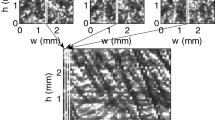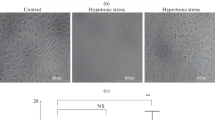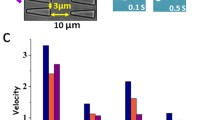Abstract
Biopolymers are naturally synthesized from algae, fungi, and plants. One among them is dextran, which has been extensively studied and still being explored to clarify its mechanistic function in supporting red blood cell (RBC) aggregation. Although its importance is widely established, in our present study, we have reexamined RBC aggregation stability by evaluating distribution of RBC rouleaux shape and its adhesive nature towards endothelial cell (EC) in a non-flowing environment. Our observation on aggregated RBC, besides showing increment in rouleaux number, also revealed increment in rouleaux size by exhibiting constant rouleaux shapes namely I-shape, L-shape, Y-shape, and clump-shaped with gradient change in dextran concentration (450–650 kDa). In addition, our study also highlights that aside from stimulating aggregation in RBC, dextran (7.5 and 10% DEX) consistently promotes single RBC adhesion towards EC than aggregated RBCs. Overall, our present study demonstrates rouleaux shape distribution and single RBC adhesion to EC as an important causative factor in provoking abnormalities. From the obtained data, we postulate that dextran-RBC interactions must be considered when designing biomaterials with dextran biopolymer for clinical applications.




Similar content being viewed by others
Abbreviations
- DEX:
-
Dextran
- DMEM:
-
Dulbecco Modified Eagle medium
- PBS:
-
Phosphate-buffered saline
- FBS:
-
Fetal bovine serum
- SFM:
-
Serum-free medium (DMEM without FBS)
References
Saenger W (1980) Cyclodextrin inclusion compounds in research and industry. Angew Chem, Int Ed Engl 19:344–362
Shoichet MS (2010) Polymer scaffolds for biomaterials applications. Macromolecules 43:581–591
Seidi F, Jin Y, Xiao H (2020) Polycyclodextrins: synthesis, functionalization, and applications. Carbohyd Polym 242:116277
Shokri Z, Seidi F, Saeb MR, Jin Y, Li C, Xiao H (2022) Elucidating the impact of enzymatic modifications on the structure, properties, and applications of cellulose, chitosan, starch and their derivatives: a review. Mater Today Chem 24:100780
Dhagat S, Jujjavarapu SE (2021) Biorefinery system for production of thermostable exopolysaccharide by a novel thermophile Brevibacillus borstelensis MK878423 and its study on impact of glucose utilization. Biomass Convers Biorefin 1–11
Farokhi M, Mottaghitalab F, Fatahi Y, Saeb MR, Zarrintaj P, Kundu SC, Khademhosseini A (2019) Silk fibroin scaffolds for common cartilage injuries: possibilities for future clinical applications. Eur Polymer J 115:251–267
Daba GM, Elnahas MO, Elkhateeb WA (2021) Contributions of exopolysaccharides from lactic acid bacteria as biotechnological tools in food, pharmaceutical, and medical applications. Int J Biol Macromol 173:79–89
Carvalho LT, Vieira TA, Zhao Y, Celli A, Medeiros SF, Lacerda TM (2021) Recent advances in the production of biomedical systems based on polyhydroxyalkanoates and exopolysaccharides. Int J Biol Macromol 183:1514–1539
Sardaremelli S, Hasanzadeh M, Seidi F (2021) Enzymatic recognition of hydrogen peroxide (H2O2) in human plasma samples using HRP immobilized on the surface of poly (arginine-toluidine blue)-Fe3O4 nanoparticles modified polydopamine; A novel biosensor. J Mol Recognit 34:e2928
Mirzaie A, Seidi F, Hasanzadeh M (2021) Low fouling and ultra-sensitive electrochemical screening of ractopamine using mixed self-assembly of PEG and aptamer immobilized on the interface of poly (dopamine)/GCE: A new apta-platform towards point of care (POC) analysis. Microchem J 171:106853
Seidi F, Zhao W, Xiao H, Jin Y, Zhao C (2020) Layer-by-layer assembly for surface tethering of thin-hydrogel films: design strat-egies and applications. Chem Rec 20:857–881
Seidi F, Zhao W, Xiao H, Jin Y, Saeb MR, Zhao C (2020) Radical polymerization as a versatile tool for surface grafting of thin hydrogel films. Polym Chem 11:4355–4381
Biswal T (2021) Biopolymers for tissue engineering applications: a review. Mater Today: Proc 41:397–402
Shokrani H, Shokrani A, Sajadi SM, Seidi F, Mashhadzadeh AH, Rabiee N, Saeb MR, Aminabhavi T, Webster TJ (2022) Cell-seeded biomaterial scaffolds: the urgent need for unanswered accelerated angiogenesis. Int J Nanomed 17:1035
Nosrati H, Pourmotabed S, Sharifi E (2018) A review on some natural biopolymers and their applications in angiogenesis and tissue engineering. J Appl Biotech Rep 5:81–91
Wu J, Yan D, Liu Y, Luo X, Li Y, Cao C, Li M, Han Q, Wang C, Wu R, Zhang L (2021) Purification, structural characteristics, and biological activities of exopolysaccharide isolated from leuconostoc mesenteroides SN-8. Front Microbiol 12:644226
Kumar AS, Mody K, Jha B (2007) Bacterial exopolysaccharides–a perception. J Basic Microbiol 47:103–117
Barcelos MCS, Vespermann KAC, Pelissari FM, Molina G (2020) Current status of biotechnological production and applications of microbial exopolysaccharides. Crit Rev Food Sci Nutr 60:1475–1495
Palomba S, Cavella S, Torrieri E, Piccolo A, Mazzei P, Blaiotta G, Ventorino V, Pepe O (2012) Polyphasic screening, homopolysaccharide composition, and viscoelastic behavior of wheat sourdough from a Leuconostoc lactis and Lactobacillus curvatus exopolysaccharide-producing starter culture. Appl Environ Microbiol 78:2737–2747
Lee SH, Park MS, Jung JY, Jeon CO (2012) Leuconostoc miyukkimchii sp. nov., isolated from brown algae (Undaria pinnatifida) kimchi. Int J Syst Evol Microbiol 62:1098–1103
Kareem AJ, Salman JAS (2019) Production of dextran from locally Lactobacillus spp Isolates. Rep Biochem Mol Biol 8:287–300
Sun G, Mao JJ (2012) Engineering dextran-based scaffolds for drug delivery and tissue repair. Nanomedicine 7:1771–1784
Bhavani AL, Nisha J (2010) Dextran—the polysaccharide with versatile uses. Int J Pharm Biol Sci 1:569–573
Ro JS, Kluge T (1971) Increased erythrocyte sedimentation rate following anti-thrombotic treatment with dextrans. Scand J Thorac Cardiovasc Surg 5:47–50
Jain RK (1988) Determinants of tumor blood flow: a review. Cancer Res 48:2641–2658
Drake CT, Macalald F, Lewis FJ (1961) The effect of low molecular weight dextran upon the blood flow during extracorporeal circulation. J Thorac Cardiovasc Surg 42:735–742
Aleman MM, Walton BL, Byrnes JR, Wolberg AS (2014) Fibrinogen and red blood cells in venous thrombosis. Thromb Res 133(Suppl 1):S38-40
Mackman N (2018) The red blood cell death receptor and thrombosis. J Clin Invest 128:3747–3749
Weisel JW, Litvinov RI (2019) Red blood cells: the forgotten player in hemostasis and thrombosis. J Thromb Haemost 17:271–282
Yedgar S, Koshkaryev A, Barshtein G (2002) The red blood cell in vascular occlusion. Pathophysiol Haemost Thromb 32:263–268
Nader E, Skinner S, Romana M, Fort R, Lemonne N, Guillot N, Gauthier A, Antoine-Jonville S, Renoux C, Hardy-Dessources MD, Stauffer E, Joly P, Bertrand Y, Connes P (2019) Blood rheology: key parameters, impact on blood flow, role in sickle cell disease and effects of exercise. Front Physiol 10:1329
Ben-Ami R, Barshtein G, Mardi T, Deutch V, Elkayam O, Yedgar S, Berliner S (2003) A synergistic effect of albumin and fibrinogen on immunoglobulin-induced red blood cell aggregation. Am J Physiol Heart Circ Physiol 285:H2663-2669
Brust M, Aouane O, Thiébaud M, Flormann D, Verdier C, Kaestner L, Laschke MW, Selmi H, Benyoussef A, Podgorski T, Coupier G, Misbah C, Wagner C (2014) The plasma protein fibrinogen stabilizes clusters of red blood cells in microcapillary flows. Sci Rep 4:4348
Girdhar G, Bluestein D (2008) Biological effects of dynamic shear stress in cardiovascular pathologies and devices. Expert Rev Med Devices 5:167–181
Ami RB, Barshtein G, Zeltser D, Goldberg Y, Shapira I, Roth A, Keren G, Miller H, Prochorov V, Eldor A, Berliner S, Yedgar S (2001) Parameters of red blood cell aggregation as correlates of the inflammatory state. Am J Physiol Heart Circ Physiol 280:H1982-1988
Tripette J, Nguyen LC, Allard L, Robillard P, Soulez G, Cloutier G (2015) In vivo venous assessment of red blood cell aggregate sizes in diabetic patients with a quantitative cellular ultrasound imaging method: proof of concept. PLoS ONE 10:e0124712
Wu YF, Hsu PS, Tsai CS, Pan PC, Chen YL (2018) Significantly increased low shear rate viscosity, blood elastic modulus, and RBC aggregation in adults following cardiac surgery. Sci Rep 8:7173
Cardoso AV, Camargos AO (2002) Geometrical aspects during formation of compact aggregates of red blood cells. Mater Res 5(3):263–268
Colin Y, Le Van Kim C, El Nemer W (2014) Red cell adhesion in human diseases. Curr Opin Hematol 21:186–192
Hillery CA, Du MC, Montgomery RR, Scott JP (1996) Increased adhesion of erythrocytes to components of the extracellular matrix: isolation and characterization of a red blood cell lipid that binds thrombospondin and laminin. Blood 87:4879–4886
Wautier JL, Wautier MP (2013) Molecular basis of erythrocyte adhesion to endothelial cells in diseases. Clin Hemorheol Microcirc 53:11–21
Baskurt OK, Meiselman HJ (2008) RBC aggregation: more important than RBC adhesion to endothelial cells as a determinant of in vivo blood flow in health and disease. Microcirculation 15:585–590
Yedgar S, Kaul DK, Barshtein G (2008) RBC adhesion to vascular endothelial cells: more potent than RBC aggregation in inducing circulatory disorders. Microcirculation 15:581–583
Gyawali P, Ziegler D, Cailhier JF, Denault A, Cloutier G (2018) Quantitative measurement of erythrocyte aggregation as a systemic inflammatory marker by ultrasound imaging: a systematic review. Ultrasound Med Biol 44:1303–1317
Edgell CJ, McDonald CC, Graham JB (1983) Permanent cell line expressing human factor VIII-related antigen established by hybridization. Proc Natl Acad Sci U S A 80:3734–3737
Li C, Li Z, Xun S, Jiang P, Yan R, Chen M, Hu F, Rupp RA, Zhang X, Pan L, Xu J (2017) Protection of the biconcave profile of human erythrocytes against osmotic damage by ultraviolet-a irradiation through membrane-cytoskeleton enhancement. Cell Death Discov 3:17040
Bonomini M, Sirolli V, Gizzi F, Di Stante S, Grilli A, Felaco M (2002) Enhanced adherence of human uremic erythrocytes to vascular endothelium: role of phosphatidylserine exposure. Kidney Int 62:1358–1363
Jayavanth S, Singh M (2004) Computerized analysis of erythrocyte aggregation from sequential video-microscopic images under gravitational sedimentation. ITBM-RBM 25:67–74
Mehri R, Mavriplis C, Fenech M (2015) Controlled microfluidic environment for dynamic investigation of red blood cell aggregation. JoVE 100:pe52719
Jambou R, Combes V, Jambou MJ, Weksler BB, Couraud PO, Grau GE (2010) Plasmodium falciparum adhesion on human brain microvascular endothelial cells involves transmigration-like cup formation and induces opening of intercellular junctions. PLoS Pathog 6:e1001021
Cicco G, Pirrelli A (1999) Red blood cell (RBC) deformability, RBC aggregability and tissue oxygenation in hypertension. Clin Hemorheol Microcirc 21:169–177
Neu B, Wenby R, Meiselman HJ (2008) Effects of dextran molecular weight on red blood cell aggregation. Biophys J 95:3059–3065
Wautier JL, Pintigny D, Wautier MP, Paton RC, Galacteros F, Passa P, Caen JP (1983) Fibrinogen, a modulator of erythrocyte adhesion to vascular endothelium. J Lab Clin Med 101:911–920
Bertoluzzo SM, Bollini A, Rasia M, Raynal A (1999) Kinetic model for erythrocyte aggregation. Blood Cells Mol Dis 25:339–349
Lee K, Kinnunen M, Khokhlova MD, Lyubin EV, Priezzhev AV, Meglinski I, Fedyanin AA (2016) Optical tweezers study of red blood cell aggregation and disaggregation in plasma and protein solutions. J Biomed Opt 21:35001
Marton Z, Kesmarky G, Vekasi J, Cser A, Russai R, Horvath B, Toth K (2001) Red blood cell aggregation measurements in whole blood and in fibrinogen solutions by different methods. Clin Hemorheol Microcirc 24:75–83
Zhang ZW, Neu B (2009) Role of macromolecular depletion in red blood cell adhesion. Biophys J 97:1031–1037
Skalak R, Zarda PR, Jan KM, Chien S (1981) Mechanics of Rouleau formation. Biophys J 35:771–781
Jovtchev S, Hristova N, Stoeff S, Galabova T, Stoylov S (2009) Investigations on the polymer induced aggregation of red blood cells. Biotechnol Biotechnol Equip 23:581–584
Avsievich T, Popov A, Bykov A, Meglinski I (2019) Mutual interaction of red blood cells influenced by nanoparticles. Sci Rep 9:1–6
Maharshak N, Arbel Y, Shapira I, Berliner S, Ben-Ami R, Yedgar S, Barshtein G, Dotan I (2009) Increased strength of erythrocyte aggregates in blood of patients with inflammatory bowel disease. Inflamm Bowel Dis 15:707–713
Samocha-Bonet D, Ben-Ami R, Shapira I, Shenkerman G, Abu-Abeid S, Stern N, Mardi T, Tulchinski T, Deutsch V, Yedgar S (2004) Flow-resistant red blood cell aggregation in morbid obesity. Int J Obes 28:1528–1534
Yalcin O, Uyuklu M, Armstrong JK, Meiselman HJ, Baskurt OK (2004) Graded alterations of RBC aggregation influence in vivo blood flow resistance. American Journal of Physiology-Heart and Circulatory Physiology 287:H2644–H2650
Weiss DJ, Geor RJ (1993) Clinical and rheological implications of echinocytosis in the horse: A review. Comp Haematol Int 3:185–189
Hortolà P (1992) SEM analysis of red blood cells in aged human bloodstains. Forensic Sci Int 55:139–159
Lerche D, Augsten K, Hessel E (1981) Scanning electron microscopical characterization of La3+- and concanavalin A-induced aggregations of untreated and neuraminidase-treated human erythrocytes. Exp Pathol 20:156–162
Zhao L, Kaewprayoon W, Zhou H, Georgieva R, Bäumler H (2017) RBC aggregation in dextran solutions can be measured by flow cytometry. Clin Hemorheol Microcirc 65:93–101
Bos GW, Hennink WE, Brouwer LA, den Otter W, Veldhuis TF, van Nostrum CF, van Luyn MJ (2005) Tissue reactions of in situ formed dextran hydrogels crosslinked by stereocomplex formation after subcutaneous implantation in rats. Biomaterials 26:3901–3909
Ferreira L, Gil MH, Cabrita AM, Dordick JS (2005) Biocatalytic synthesis of highly ordered degradable dextran-based hydrogels. Biomaterials 26:4707–4716
Luo Y, Kobler JB, Heaton JT, Jia X, Zeitels SM, Langer R (2010) Injectable hyaluronic acid-dextran hydrogels and effects of implantation in ferret vocal fold. J Biomed Mater Res B Appl Biomater 93:386–393
Acknowledgements
We would like to thank the Centre for nanoscience and technology, Anna University, Chennai, India for the instrumental facility. All the authors thank Dr. Suvro Chatterjee lab members (Suganya Natarajan, Harshini Sridharan and Prattusha Sengupta) for their assistance in this study.
Funding
This work was supported by a grant from Centre for research, Anna University, India, to MV; the University Grant Commission-Faculty Research Program (UGC-FRP), Government of India, to SC.
Author information
Authors and Affiliations
Contributions
MV prepared the manuscript, performed the experiments, and analyzed the data; SC supervised and designed the experiments and approved the manuscript. SVN contributed to the discussion and reviewed the manuscript. All authors reviewed the manuscript.
Corresponding authors
Ethics declarations
Research involving human participants
The study protocol was approved by the Institutional Biosafety and Ethical Committee of AU-KBC Research Centre, Chennai, India (Annexure I: Project Number III dated 19 July 2016).
Conflict of interest
The authors declare no competing interests.
Additional information
Publisher's note
Springer Nature remains neutral with regard to jurisdictional claims in published maps and institutional affiliations.
Rights and permissions
About this article
Cite this article
Vijayaraghavan, M., Chatterjee, S., Sumantran, V.N. et al. Revisiting dextran effect on red blood cell to understand the importance of rouleaux distribution and red blood cell-endothelial cell adhesion. Biomass Conv. Bioref. (2022). https://doi.org/10.1007/s13399-022-02851-0
Received:
Revised:
Accepted:
Published:
DOI: https://doi.org/10.1007/s13399-022-02851-0




